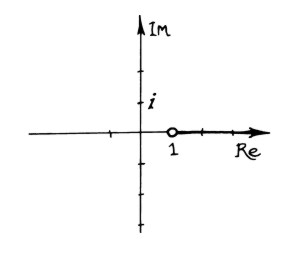
The real number line is contained within a larger number system, the plane of complex numbers of the form z = a + ib where a and b are reals. Here i is the imaginary unit, defined to be the square root of –1 which is a property not possessed by any real number. The complex plane
 represented above has a real axis consisting of all complex
numbers z with imaginary part zero, and an imaginary axis
consisting of all complex numbers z with real part zero.
represented above has a real axis consisting of all complex
numbers z with imaginary part zero, and an imaginary axis
consisting of all complex numbers z with real part zero.The darker portion of the real axis shows the domain of definition for the real-valued zeta function. By a very important process called analytic continuation, the zeta function can be extended in a unique way to be defined over the entire complex plane, with the exception of the point z = 1, where it effectively becomes infinite. This point is known as a simple pole of the (analytically continued) Riemann zeta function.
This newly extended zeta function is not only defined on complex values, but is also complex-valued, i.e. ζ(z) is not generally a real number. For this reason, it is not easy to display its behaviour with a static graph. It maps points in
 to other points in
to other points in  , so it is
perhaps best to try to imagine it in more "dynamic" terms. Just as the
real-valued zeta function essentially maps the (real) interval x
> 1 onto itself by "inverting" it in a very particular and important
way, the complex-valued Riemann zeta function can be thought of roughly as
"turning the complex plane inside-out" in a very particular and
profoundly important way. This "turning inside-out" mapping is far
from simple, as we shall go on to see.
, so it is
perhaps best to try to imagine it in more "dynamic" terms. Just as the
real-valued zeta function essentially maps the (real) interval x
> 1 onto itself by "inverting" it in a very particular and important
way, the complex-valued Riemann zeta function can be thought of roughly as
"turning the complex plane inside-out" in a very particular and
profoundly important way. This "turning inside-out" mapping is far
from simple, as we shall go on to see.